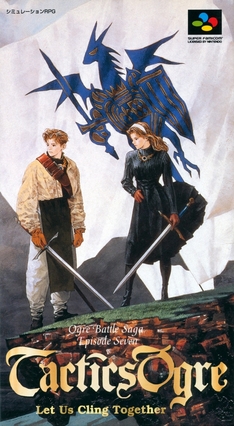
Tactics Ogre: Let Us Cling Together is a 1995 tactical role-playing game developed and published by Quest Corporation for the Super Famicom. It was later ported to the Sega Saturn (1996) and the PlayStation (1997), the latter released in North America in 1998 by Atlus USA. The second entry in the Ogre Battle series, the story takes place in the war-torn kingdom of Valeria, where protagonist Denim Powell works in a local resistance force against occupying powers, ending up caught in the ethnic conflicts driving the war. Battles are turn-based, taking place on grid-based maps from an overhead perspective with a focus on positioning and using character class abilities.
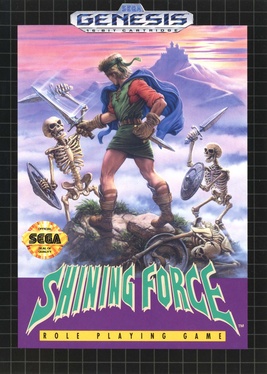
Shining Force is a 1992 turn-based tactical role-playing game for the Sega Genesis console. It is the second entry of the Shining series of video games, following Shining in the Darkness. While primarily a traditional fantasy-themed game, it contains some science fiction elements.
Tactical role-playing games, also known as strategy role-playing games and in Japan as simulation RPGs, are a video game genre that combines core elements of role-playing video games with those of tactical strategy video games. The formats of tactical RPGs are much like traditional tabletop role-playing games and strategy games in appearance, pacing, and rule structure. Likewise, early tabletop role-playing games are descended from skirmish wargames such as Chainmail, which were primarily concerned with combat.
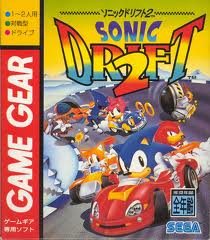
Sonic Drift 2, released in Europe as Sonic Drift Racing, is a kart racing video game by Sega for the Game Gear. The sequel to Sonic Drift, it was released in Japan and Europe in April 1995 and in North America in November 1995. It added three characters: Knuckles, Fang the Sniper, and Metal Sonic, and marked the first time the last two were playable characters. Sonic Drift 2 was later released worldwide as part of Sonic Adventure DX in 2003 and the compilation game Sonic Gems Collection in 2005. It was released again in 2023 as part of Sonic Origins Plus.

Langrisser is a fantasy tactical role-playing video game series created by Masaya Games. The main development team is Career Soft, first as Team Career within Masaya Games for the first three games and then as an independent studio for Langrisser IV and V. The series has a fantasy-Germanic setting, but draws on religious concepts like ditheism and sword worship for historical context. The series was originally released for Sega platforms during the 1990s, with the first two installments originally made for the Mega Drive, followed by third through fifth installments for the Sega Saturn. Ports and remakes were also made for other platforms such as PC Engine, Super Famicom, PC-FX and PlayStation during the same period.

Fire Emblem Gaiden is a tactical role-playing game developed by Intelligent Systems and published by Nintendo for the Famicom. Released in March 1992, it is the second installment in the Fire Emblem series and the last to be developed for the Famicom. It builds upon the basic turn-based strategy gameplay of the previous title, while including new elements such as a navigable overworld. Set in the same world as its predecessor, Fire Emblem: Shadow Dragon and the Blade of Light, Gaiden follows the battles of two opposing armies on the continent of Valentia, which is torn apart by political strife involving the princess Celica and her childhood friend Alm.

Shining Force II is a tactical role-playing game for the Mega Drive/Genesis console developed by Sonic! Software Planning and published by Sega in 1993. Its storyline is not directly connected to the original Shining Force, although a Game Gear title Shining Force Gaiden: Final Conflict links the two games' plots.

Shining Force III is a tactical role-playing game released for the Sega Saturn. In Japan, Shining Force III was an episodic video game with three discs - Scenario 1, Scenario 2, and Scenario 3 - released individually across late 1997 and 1998. Game data could be saved and transferred forward to later scenarios in order to influence events and obtain rewards in-game, a mechanic marketed as the "Synchronicity system". Each scenario utilizes the same core gameplay mechanics, but follows a different character's perspective of the overarching narrative in a shared game world. In North America and Europe, only the first entry, Scenario 1, was translated into English, and was simply titled Shining Force III for its release in mid-1998.

Famicom Wars is a turn-based strategy video game developed by Nintendo and Intelligent Systems and published by Nintendo for the Family Computer. It was released on August 12, 1988, in Japan. It was later re-released on Virtual Console. It is the first game in the Wars series.

Fire Emblem: Shadow Dragon and the Blade of Light is a 1990 tactical role-playing video game developed by Intelligent Systems and Nintendo and published by Nintendo for the Family Computer. It is the first installment in the Fire Emblem series and was originally released in Japan. Set on the fictional continent of Archanea, the story follows the tale of Marth, prince of the kingdom of Altea, who is sent on a quest to reclaim his throne after being forced into exile by the evil sorcerer Gharnef and his dark master Medeus, the titular Shadow Dragon. Forming new alliances with neighboring kingdoms, Marth must gather a new army to help him retrieve the sacred sword Falchion and the Fire Emblem shield in order to defeat Gharnef and Medeus and save his kingdom. The gameplay revolves around turn-based battles on grid-based maps, with defeated units being subject to permanent death.

Fire Emblem: Thracia 776 is a tactical role-playing game developed by Intelligent Systems and published by Nintendo for the Super Famicom; it was originally released through the Nintendo Power flash cartridge in 1999, then on a ROM cartridge the following year. It is the fifth installment in the Fire Emblem series, the third and last title to be developed for the Super Famicom, and the last home console Fire Emblem until the release of Fire Emblem: Path of Radiance in 2005.
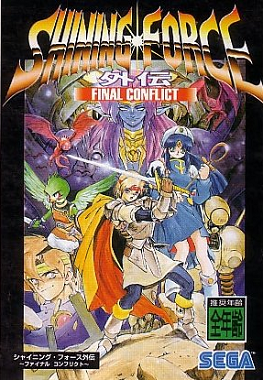
Shining Force Gaiden: Final Conflict is a 1995 tactical role-playing game for the Game Gear, taking place between the games Shining Force and Shining Force II. It was released after both games, with the intention of connecting their plots. Despite its name, it is not directly story-related to Shining Force Gaiden or Shining Force Gaiden II, also released for Game Gear. Unlike most of its predecessors, the game was never released outside Japan. English patches have been created by fans for players who cannot read Japanese.

Mystaria: The Realms of Lore, released as Riglord Saga in Japan, is a tactical role-playing game for the Sega Saturn. In late 1996 it was re-released as Blazing Heroes in North America. Its graphics consist of pre-rendered sprites and polygonal backgrounds. Its sequel, Riglord Saga 2, was released in Japan only in 1996.

Dark Wizard, known in Japan as Dark Wizard: Yomigaerishi Yami no Madoushi, is a role-playing video game developed and published by Sega for the Sega CD.

Langrisser, originally spelled Lungrisser in the Mega Drive version and first released in North America as Warsong, is a tactical role-playing game developed by Nippon Computer Systems (NCS). The first in the Langrisser series, it blended tactical warfare with RPG elements, similar to the Fire Emblem series. It was initially released for the Mega Drive/Genesis console and later the PC Engine, the former version being published by Treco in America. The PC-Engine version was released under the title Langrisser: The Descendants of Light. It was later re-released alongside Der Langrisser in a compilation for the Sega Saturn and PlayStation. That compilation was released for the PlayStation Network in 2009. A full remake of Langrisser I & II was also released in 2019 on both Sony PlayStation 4 and Nintendo Switch and on PC in 2020, featuring new graphics and BGM and also new playable characters and multiple paths through the game for Langrisser I.
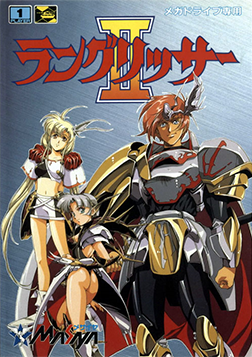
Langrisser II is a tactical role-playing game for the Sega Mega Drive console. It is the sequel to Langrisser, and was never released outside Japan. Langrisser II was remade for the Super Famicom by Masaya as Der Langrisser, which featured multiple paths through the game, greatly reduced difficulty, and reworked graphics. A PC-FX port, Der Langrisser FX, was also released, featuring animated cutscenes. It was later compiled with the first Langrisser for the PlayStation as Langrisser I & II , and then given a script edit and new branch of the Imperial path in its Saturn remake as Langrisser: Dramatic Edition. A Windows 98 port of the game was released in Japanese, Chinese and Korean; it features redrawn, high-resolution graphics, but a vastly trimmed-down soundtrack to fit the confines of a standard CD. A full remake of Langrisser I & II was also released in 2019 on both Sony PlayStation 4 and Nintendo Switch and on PC in 2020, featuring new graphics and BGM.

Shining Blade is a tactical role-playing game developed and published by Sega for the PlayStation Portable. It is the fourth Shining game with characters designed by Tony Taka, the other three being Shining Tears, Shining Wind and Shining Hearts. Shining Blade was released in Japan on March 15, 2012.

4th Super Robot Wars is a tactical RPG for the Super Famicom developed by both Banpresto and Winky Soft and published by Banpresto. It is the 5th entry in the Super Robot Wars series and the last entry in the Classic Timeline. It was first released on March 17, 1995, and received mostly positive reception, with reviewers highly praising the improvements from the last game while criticizing the game's increased difficulty. The game was ported to the Sony PlayStation and released on January 26, 1996, under the name 4th Super Robot Wars Scramble.
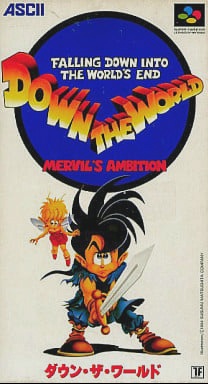
Down the World: Mervil's Ambition is a role-playing video game (RPG) developed and published by ASCII Corporation for the Super Famicom. The plot follows the knight Gao, tasked with accompanying a hero in rescuing an ailing princess and preventing the end of all life.



















